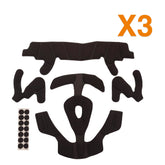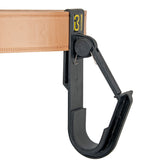An important part of the suspension phase in any fall is rescue, either self rescue or by another person, and the treatment of the casualty during and after the rescue. It is essential that a rescue plan and resources are in place at the work-site and that they are continually assessed and updated and practiced on a regular basis. The responsibility for creating an effective rescue plan lies with the employer and senior management. Creating a Emergency Evacuation and Rescue Plan for Scaffolding. Effective rescue plans should include the following procedures for:
- Limiting the time the casualty is suspended.
- Rescuing the casualty, either self rescue or by another person / persons.
- Emergency treatment during and after the rescue.
- Quickly identifying the symptoms and signs of orthostatic intolerance, orthostatic syndrome, harness induced pathology or suspension trauma.
A Medical Emergency
Harnesses can become deadly. An employee who suffers a fall and is suspended in a fall arrest system should always be treated as a medical emergency. The stress of hanging in a safety harness (suspension trauma) can lead to orthostatic intolerance, serious injury and even death. The casualty must be rescued as quickly and as safely as possible. After rescue the casualty should always be taken to the nearest Accident & Emergency for a medical examination.
Further effects
Loss of consciousness assures that a suspended person will not be moving his or her limbs, so venous pooling will increase, which will in turn reduce the circulating blood volume even further. In addition, any restrictions of the femoral arteries and veins caused by the safety harness straps could be a contributory factor to venous pooling. Thus, the detrimental effects are increased. These include not only a potentially fatal reduced blood flow to the brain, but also the effect on other vital organs, such as the kidneys.
The kidneys are also very sensitive to blood oxygen levels and renal failure as a result of excessive venous pooling is a real possibility. Unless the casualty is rescued very quickly and unless the rescuers follow a particular procedure, the effects of venous pooling and any associated loss of consciousness are likely to lead to death, as the brain and kidneys are deprived of vital oxygen.
Moving the casualty quickly into a horizontal position, a natural reaction, is likely to cause a massive return of deoxygenated and possibly toxic blood to the heart, which is then unable to cope, causing cardiac arrest. It is vitally important that the casualty is put into a sit position with their knees bent in a "W" position, ideally against a solid structure for approx 30 - 40 minutes to allow the blood to be released slowly.
Orthostatic intolerance – Suspension Trauma Symptoms and Signs
- Nausea
- Faintness
- Breathlessness
- Dizziness
- Sweating
- Unusually low heart rate
- Unusually low blood pressure
- Paleness
- Hot flushes
- Skin tone may appear grey in colour
- Loss of vision
- Increased heart rate
Practicing your Rescue Plan
Working at Height Regulations state that rescue procedures must be practiced on a regular basis. The regular practicing of your rescue plan is just as important and the plan its self.
Developing your Rescue Plan
- If a person falls and is suspended in a fall arrest system can they be rescued quickly and safely?
- If a person falls how will others know?
- Who will likely see the fall first?
- What is the protocol when calling the emergency services?
- What information will be given to the emergency services?
- What communication system will be used between the suspended operative and the rescue team?
- Rescuing the casualty, either self rescue or by a rescue team?
- Can you get the casualty out of suspension?
- How will the safety of the rescuers be assured, as well as that of the suspended casualty?
- How will rescue personnel get to the suspended casualty?
- What rescue equipment will be required to rescue the casualty quickly and safely?
- Where is the rescue equipment going to be located / stored?
- How will rescue be performed with quickly to minimize the risk of further injury or death due to suspension trauma?
- What is the procedure if the fallen casualty is injured?
- How will the accident scene be controlled?
- Are there other considerations?
Rescue Plan for Scaffolding: Related articles


















